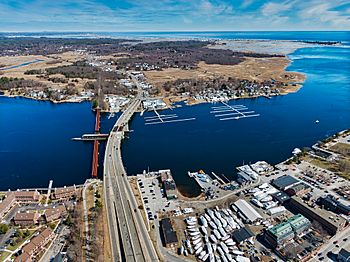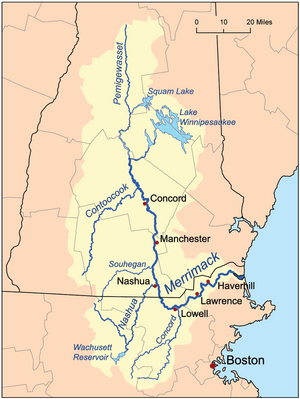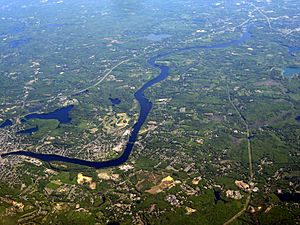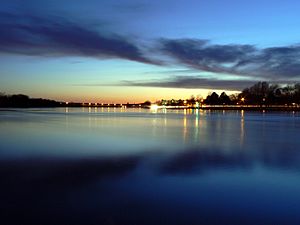Merrimack River facts for kids
Quick facts for kids Merrimack River |
|
|---|---|

Mouth of Merrimack River in Newburyport, Mass.in 2021
|
|

The Merrimack River and its major tributaries
|
|
| Other name(s) | Merrimac River |
| Country | United States |
| State | New Hampshire Massachusetts |
| Region | New England |
| Cities | Concord, NH, Manchester, NH, Nashua, NH, Lowell, MA, Lawrence, MA, Haverhill, MA, Newburyport, MA |
| Physical characteristics | |
| Main source | Pemigewasset River-Winnipesaukee River juncture Franklin, Merrimack County, New Hampshire 280 ft (85 m) 43°26′11″N 71°38′53″W / 43.43639°N 71.64806°W |
| River mouth | Gulf of Maine Newburyport, Essex County, Massachusetts 0 ft (0 m) 42°49′10″N 70°48′43″W / 42.81944°N 70.81194°W |
| Length | 117 mi (188 km) |
| Basin features | |
| Basin size | 5,010 sq mi (13,000 km2) |
| Tributaries | |
The Merrimack River is a 117-mile-long (188 km) river in the northeastern United States. It starts where the Pemigewasset and Winnipesaukee rivers meet in Franklin, New Hampshire. The river then flows south into Massachusetts. After that, it turns northeast and empties into the Gulf of Maine near Newburyport.
This river is very important to both New Hampshire and Massachusetts. The area around the river is called the Merrimack Valley. Many cities and towns are located along its banks.
Several U.S. Navy ships have been named after this river. The Merrimack River is also famous from the book A Week on the Concord and Merrimack Rivers by Henry David Thoreau.
Contents
What's in a Name?

The name "Merrimack River" has an interesting history. It's not completely clear where the name comes from. However, many believe it comes from Native American languages.
In 1604, native people told French explorers about a beautiful river to the south. The French heard its native name as Merremack. Later, in 1605, explorer Samuel de Champlain found the river.
Native American groups like the Agawam, Pawtucket, and Pennacook lived along the river. They were part of the Algonquian language family. Some historians think "Merremack" means "the place of strong current." This makes sense because the river has many rapids. Other ideas suggest it might mean "Sturgeon River," after a type of fish.
Over time, the spelling of the river's name changed. You might see it spelled "Merimacke," "Merimack," or "Merrimacke" in old records. Today, "Merrimack" is the official spelling.
A Look at Merrimack River History
The Merrimack River has played a big role in the history of New England. Long ago, before glaciers melted, the river flowed differently. It used to go much further south, near Boston. But when the glaciers retreated, they left behind lots of dirt and rocks. This changed the river's path, making it bend northeast at Lowell.
In the 1800s, many cities grew along the Merrimack River. These cities, like Concord, Manchester, Nashua, Lowell, and Lawrence, used the river's power. They built large textile mills that made cloth. Before canals were built, cities like Newburyport were important for shipbuilding. They used timber that floated down the river from New Hampshire.
Where is the Merrimack River?
The Merrimack River's watershed is a large area. It covers about 5,010 square miles (12,980 km2) in southern New Hampshire and northeastern Massachusetts. This makes it the fourth largest river system in New England.
The river starts in Franklin, New Hampshire. This is where the Pemigewasset and Winnipesaukee rivers join together. From Franklin, the Merrimack flows south through cities like Concord, Manchester, and Nashua.
It then enters Massachusetts near Tyngsborough. Here, it turns northeast. The river flows past or through many towns and cities. These include Lowell, Lawrence, Haverhill, and Amesbury. Finally, it reaches the Gulf of Maine between Newburyport and Salisbury.
Major River Branches
The Merrimack River has many smaller rivers and streams that flow into it. These are called tributaries. The U.S. Geological Survey groups them into six main areas.
- In New Hampshire
- In both New Hampshire and Massachusetts
- In Massachusetts
Other Important Rivers
Here are some other important rivers that are part of the Merrimack watershed, listed as you go downstream:
- Soucook River
- Suncook River
- Piscataquog River
- Cohas Brook
- Souhegan River
- Salmon Brook
- Stony Brook
- Beaver Brook
- Spicket River
- Shawsheen River
- Little River
- Powwow River
Yes, the Merrimack River is considered one of the Navigable Waters of the United States. This means certain rules apply to boats and other activities on the river.
Merrimack River Flooding Events

The Merrimack River can sometimes experience flooding. One notable flood happened on May 15, 2006. Heavy rainfall caused the river to rise more than 8 feet (2.4 m) above its normal level. This forced people to leave their homes and damaged property. Some areas received as much as 17 inches (43 cm) of rain.
During this flood, the city of Lowell had to install a special flood control gate. This gate, called the Francis Gate, helps protect the city's canal system from the swollen river. It was first built in 1850 and has saved the city from flooding many times.
Other Major Floods
The biggest flood ever recorded on the Merrimack River was in March 1936. A lot of rain and melting snow made the river rise very high. It was 10 feet (3 m) higher than the 2006 flood!
Other serious floods happened in 1852, during the New England Hurricane of 1938, and in April 2007. The Francis Gate helped prevent damage in 1938 and 2007 too.
Merrimack River in Media
The Merrimack River has also appeared in songs and books.
- The song "Merrimack River" is on the 2009 album Amanda Leigh by singer Mandy Moore, who is from Nashua, New Hampshire.
- The historical novel Avalon by Anya Seton includes a story about early travelers arriving at the Merrimack River.
Category:Merrimack RiverCategory:Rivers of Essex County, MassachusettsCategory:Rivers of Middlesex County, MassachusettsCategory:Rivers of New HampshireCategory:Concord, New HampshireCategory:Geography of Lowell, MassachusettsCategory:Nashua, New HampshireCategory:Lawrence, MassachusettsCategory:Haverhill, MassachusettsCategory:Rivers of MassachusettsCategory:Rivers of Merrimack County, New HampshireCategory:Rivers of Hillsborough County, New HampshireCategory:Watersheds of the United States
See also
 In Spanish: Río Merrimack para niños
In Spanish: Río Merrimack para niños



